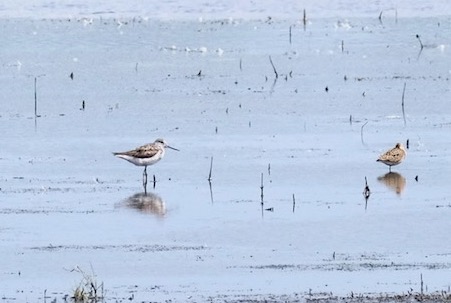On Wednesday we went to Alkborough Flats, and were rather surprised to find the Glossy Ibis was still present. We enjoyed good views at the hide and later along the large shallow flash. Other birds seen included Black-tailed Godwit, Spotted Redshank, Avocet, Dunlin, Lapwings, Little Egret and various eclipse ducks. Eventually, we saw a few Reed Warblers and a pair of Bearded Tits. One more highlight was an immature Cuckoo.
Glossy Ibis & Others
Glossy Ibis - showing the gloss
ditto
ditto
ditto
ditto
Glossy Ibis in Portugal (c) 2021 Hugh Wood
Immature Cuckoo
ditto
ditto
Greenshank [left] & Immature Ruff
Lapwing
Fish
Red Arrow
On Thursday we made out final visit of 2021 to Barlow Common. Some of the flowering species had died back, including the stunning field of Lady’s Bedstraw, which was virtually empty. The Wild Parsnip was also waning, as was the St John’s Wort. One exception was the Mullein, which if anything was more prolific than during our earlier visits. Am immature Whitethroat being fed by one of its parents was an early highlight. When we reached the first pond a young Green Woodpecker flew right across our field of view. There were at least two young Sparrowhawks calling feebly in the woodland. There were plenty of butterflies in the sunshine, but most of them were faded. The exception this time were three very fresh Painted Ladies, which were much brighter than the faded examples we had seen a few weeks ago. We saw both Migrant and Brown Hawkers, but they refused to settle to have their photograph taken.
Immature Whitethroat
Heron
Painted Lady
Ditto
Common Blue
Meadow Brown on Teasle
Brimstone
Yellowwort
Ragwort
Mullein
Evening Primrose
Centaury
Rowan Berries
Sinister Figure Watching from the side of the fishing lake
On Friday because of a terrible forecast we switched to Tophill Low. The morning remained completely dry. The only birds at Watton Borrow Pits appeared to be to Green Sandpipers, but then we saw a Barn Owl by the side of a box opposite to us. On South Marsh West a few Sand Martins were still using the nesting wall. A Mute Swan family including 5 cygnets were the only other species of note from this viewpoint. South Marsh East had been invaded by Lapwings, but Ian managed to point out a Common Sandpiper. When we reached the back-to-back hides we saw another Green Sandpiper on the logs in front of the hide. This may be the best view of that species I’ve ever seen. This Friday proved to be the opposite of the previous week. The morning was completely dry, but the afternoon mainly consisted of continual downright downpours. The paths and approach roads were badly flooded.
Barn Owl
ditto
Green Sandpiper
ditto
ditto
ditto
Showing the white rump
Lapwing
Common Terns
Immature Common Tern
Snipe
Tufted Duck family
Damselfy
ditto
Four-Spotted Chaser
Migrant Hawker
Small White
Green-veined White
Red Admiral
Immature Little Ringed Plover



















































No comments:
Post a Comment